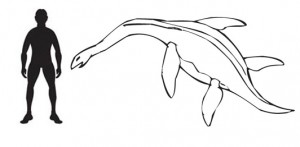The Remarkable Plesiosaurus – “A Snake Threaded Through the Shell of a Turtle”
Re-Reading old Papers on Plesiosaurus
Everything Dinosaur team members take a look at the remarkable marine reptile known as Plesiosaurus.
There was a time before the naming and describing of the Dinosauria, that ancient marine reptiles were the strange and bizarre creatures that puzzled those academics and erudite clergy and gentlemen who were at the dawn of the science of palaeontology. It is fascinating to re-visit some of the early papers and scientific reports; the language used is often very colourful and quite flowery as various “antediluvian” (means before the Biblical flood) beasties are described. Many of the papers written in the 18th and early 19th Centuries use modern, extant animals as comparators with the extinct animals for example, William Stuckley wrote in 1719 about a part human/part crocodile skeleton that had been unearthed. Careful not to be accused of heresy, Stuckley described the reptilian features of this strange half human, half crocodile person but went onto add that this poor fellow drowned in the great flood that covered the Earth as stated in the Bible. He even gave an approximate date for the demise of this person, saying that the fossil (as that was what it was); was at least 3,000 years old.
Despite William Stuckley’s great care and studious work, he was approximately 230 million years out or so in his estimate of the bizarre animal’s age. For he was describing the partial remains of a Triassic nothosaur, an early marine reptile, a group of animals that were amongst the first terrestrial animals to return to a life in the sea. Some of these long-necked, fish eaters reached lengths in excess of 8 metres and it is believed by a number of scientists that these types of creature are the ancestors of the better known plesiosaurs and pliosaurs of the Jurassic.
To view a model of a Jurassic plesiosaur and dinosaur toys, take a look at the CollectA Prehistoric Life model range: CollectA Age of Dinosaurs Prehistoric Life Models.
We have just been reading some of the old papers written about Plesiosauria – the name of the order to which animals such as the genus Plesiosaurus belongs. Although, fossils of these marine reptiles had been found in the 16th and 17th Centuries it was not until Mary Anning unearthed a nearly complete and articulated specimen at Lyme Regis (Dorset, England), in 1821 that the genus was named. As a woman, Mary Anning’s contribution to the academic study of these ancient creatures could not be recognised, nor could she be permitted to work alongside the principal scientists or publish work in her own name. It was the English geologist and Dean, William Conybeare who was given the responsibility for describing and naming these strange fossilised animals. It was William in collaboration with another English geologist Henry de la Beche, who first used the term Plesiosaurus and it was Dean Conybeare who named and described the holotype specimen of Plesiosaurus in 1824.
A Scale Drawing of Plesiosaurus (P. dolichodeirus)
Picture credit: Everything Dinosaur
The name Plesiosaurus is from the Greek, it means “near to lizard”. This is in reference to Conybeare’s comparison between plesiosaurs and the the ichthyosaurs, that had been discovered a few years earlier. Conybeare thought that the plesiosaur represented a transitional form between the ichthyosaurs and modern crocodiles. This is reflected in the title of his scientific paper on Plesiosaurus written in 1824 and presented to the Geological Society – “Notice on the discovery of a new fossil animal forming a link between the Ichthyosaurus and the Crocodile”.
The description and careful drawings of the fossils of Plesiosaurus led the Reverend William Buckland, the English clergyman and geologist who named and described the first dinosaur (Megalosaurus) to remark that Plesiosaurus resembled “A snake threaded through the shell of a turtle”. Again, wonderful Georgian language, colourful and in the case of Plesiosaurus we can see what the Reverend Buckland was on about, indeed the plesiosaurs may be more closely related to the Squamata (snakes and lizards) than they are to the Dinosauria.


